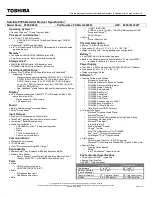
Security functions
Trusted Platform Module (TPM) (device-dependent)
TPM
Trusted PlatformModule
To use the TPM, you must activate the TPM in the
BIOS Setup
before the software
is installed
. The condition for this is that you have assigned at least the supervisor
password (see
).
Instructions for how to call up and use the
BIOS Setup Utility
can be found in
section
"Settings in BIOS Setup Utility", Page 60
.
Enabling TPM
•
Requirement: You have set a supervisor password, see
.
►
Call up the BIOS Setup and select the
Security
menu.
►
Mark the
TPM (Security Chip) Setting
fi
eld and press the Enter key
►
Select the
"Security Chip" "Enabled"
entry to activate the TPM
Once you have activated the TPM through a reboot, the
Clear Security Chip
menu option appears.
With
Clear Security Chip
, you can delete the owner in the TPM, if the TPM has already
been used. With
Enabled
, all secret keys generated by applications (e.g. SRK - Storage
Root Keys, AIK - Attestation Identity Keys, etc.) are deleted.
Please note that you will then no longer be able to access the data you have
encrypted with the keys based on that holder.
►
Select the
Exit Saving Changes
option in the Exit menu.
►
Press the Enter key and select
Yes
.
The notebook will restart, and TPM will be enabled after the reboot.
Disabling TPM
•
Requirement: You have set a supervisor password, see
.
►
Call up the BIOS Setup and select the
Security
menu.
►
Mark the
TPM (Security Chip) Setting
fi
eld and press the Enter key.
►
Select the
"Security Chip" "Disabled"
entry to deactivate the TPM
►
From the
Exit
menu, choose the option
Exit Saving Changes
.
►
Press the Enter key and select
Yes
.
Your notebook will now restart and TPM will be disabled.
Fujitsu
51
Summary of Contents for LIFEBOOK U9311
Page 1: ...System Operating Manual FUJITSU LIFEBOOK U9311 ...
Page 3: ......
Page 10: ...Contents 6 Fujitsu ...
Page 83: ...Index Fujitsu 79 ...
















































